Related Research Articles
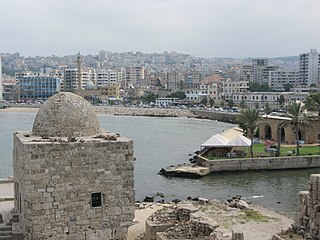
Sidon or Saida is the third-largest city in Lebanon. It is located on the Mediterranean coast in the South Governorate, of which it is the capital. Tyre, to the south, and the Lebanese capital of Beirut, to the north, are both about 40 kilometres away. Sidon has a population of about 80,000 within the city limits, while its metropolitan area has more than a quarter-million inhabitants.
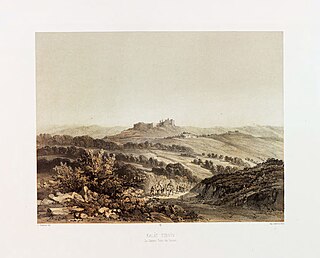
Toron, now Tibnin or Tebnine in southern Lebanon, was a major Crusader castle, built in the Lebanon mountains on the road from Tyre to Damascus. The castle was the centre of the Lordship of Toron, a seigneury within the Kingdom of Jerusalem, actually a rear-vassalage of the Principality of Galilee.

Belvoir Castle, also called Coquet by the Crusaders, also Kochav HaYarden and Kawkab al-Hawa, is a Crusader castle in northern Israel, on a hill on the eastern edge of the Issachar Plateau, on the edge of Lower Galilee 20 kilometres (12 mi) south of the Sea of Galilee. Gilbert of Assailly, Grand Master of the Knights Hospitaller, began construction of the castle in 1168. The castle ruin is located in Belvoir National Park, officially Kochav HaYarden National Park. It is the best-preserved Crusader castle in Israel.
Pappenheim was a German county in western Bavaria, Germany, located on the Altmühl river between Treuchtlingen and Solnhofen, and south of Weißenburg. As former sovereign family, mediatized to Bavaria in 1806, the family which ruled the state belongs to High nobility.
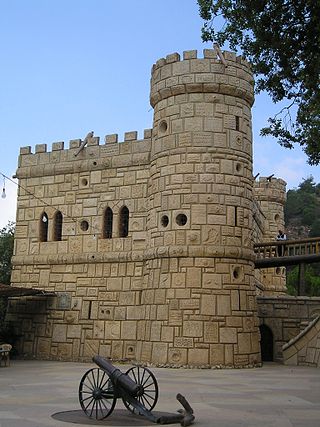
Moussa Castle is a castle between Deir el Qamar and Beit ed-Dine in Lebanon.

Hasbaya or Hasbeiya is a town in Lebanon, situated at the foot of Mount Hermon, overlooking a deep amphitheatre from which a brook flows to the Hasbani River. In 1911, the population was about 5,000.
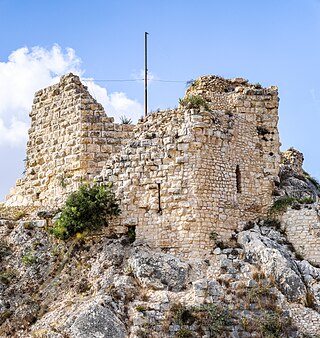
Beaufort or Belfort Castle, known locally as Qal'at al-Shaqif or Shaqif Arnun, is a Crusader fortress in Nabatieh Governorate, Southern Lebanon, about 1 kilometre (0.62 mi) to the south-south-east of the village of Arnoun. There was a fortification on the site before it was captured by Fulk, King of Jerusalem, in 1139 and construction of the Crusader castle probably began soon after. Saladin captured Beaufort in 1190, but 60 years later Crusaders re-took it. In 1268 Sultan Baibars finally captured the castle for the Islamic forces.

Our Lady of Mantara is a Melkite Greek Catholic Marian shrine in Maghdouché, Lebanon, discovered on 8 September 1721 by a young shepherd. The grotto, which according to a legend dates to ancient times, was subsequently cared after by Monsignor Eftemios Saïfi, Melkite Catholic bishop of the Melkite Greek Catholic Archeparchy of Sidon. The shrine consists of a tower crowned with the statue of the Virgin and Child, a cathedral, a cemetery and a sacred cave believed to be the one where the Virgin Mary rested while she waited for Jesus while he was in Tyre and Sidon. Since its discovery, it has been steadily visited by families particularly each year on the occasion of the feast of the Nativity of Mary on 8 September.

The Embriaco family were a prominent Genoese family, who played an important role in the history of the Crusader states. It also gave consuls, admirals and ambassadors to the Republic of Genoa.

The Tyre District is a district in the South Governorate of Lebanon.
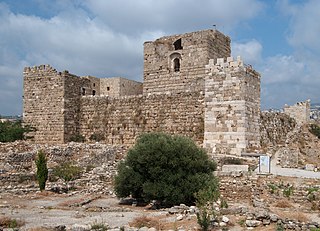
Byblos Castle is a Crusader castle in Byblos, Lebanon. In Crusader times it was known as the Castle of Gibelet, also spelled Giblet, which belonged to the Genoese Embriaco family, Lords of the city. It is adjacent to the Phoenician archaeological site containing the ruins of the Temple of Baalat Gebal and the Temple of the Obelisks.

Rashaya District is an administrative district in the Beqaa Governorate of the Republic of Lebanon.
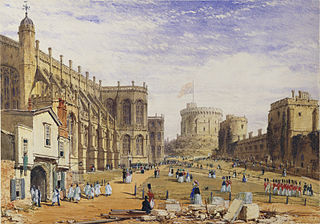
The Dean and Canons of Windsor are the ecclesiastical body of St George's Chapel at Windsor Castle.

The Citadel of Tripoli is a 12th-century fortress in Tripoli, Lebanon. It was built at the top of a hill "during the initial Frankish siege of the city between 1102 and 1109" on the orders of Raymond de Saint-Gilles, who baptized it the Castle of Mount Pilgrim while local Muslims have been referring to it as the Castle of Saint-Gilles.

Nahal Kziv or the Horn Valley is a 39-kilometer long perennial stream in the Upper Galilee, Israel. During the winter, rainfall fills the channel, and springs along the riverbed add to the flow. Currently, Mekorot pumps the water of the river's principal spring, Ein Ziv, and supplies it to the residents of the Western Galilee, making the channel between Ein Ziv and Ein Tamir an intermittent stream. On the southern ridge overlooking the valley sits a 12th-century Crusader castle, Montfort, the old headquarters of the Teutonic Order in the Holy Land.
Wadi al-Taym, also transliterated as Wadi el-Taym, is a wadi that forms a large fertile valley in Lebanon, in the districts of Rachaya and Hasbaya on the western slopes of Mount Hermon. It adjoins the Beqaa Valley running north to south towards the Jordan Valley where it meets the northwest corner of Lake Huleh. Watered by the Hasbani river, the low hills of Wadi al-Taym are covered with rows of silver-green olive trees with the population in the area being predominantly Druze and Sunni, with a high number of Christians, mostly Greek Orthodox. Wadi al-Taym is generally considered the "birthplace of the Druze faith".
The Ancient Tell is a Tell in downtown Beirut, Lebanon. In the 1990s, the effort to rebuild Beirut following the Lebanese Civil War provided archaeologists with the unique opportunity to investigate the Tell, revealing many layers of the city.

Beirut Castle was a major Crusader castle located in downtown Beirut, Lebanon. It was mostly built during the Crusades and demolished during works of extension of the Port of Beirut in the late 19th century.

Chamaa is a village and municipality in the Tyre District of Lebanon's South Governorate, about 25 kilometres southeast of Tyre and some 99 kilometres south of Beirut.
References
- ↑ Jean Richard (1999). The Crusades, C.1071-c.1291. Cambridge University Press. p. 141. ISBN 978-0-521-625661.
- ↑ Crusader Castles of Lebanon
33°09′21″N35°09′50″E / 33.1558°N 35.1639°E
